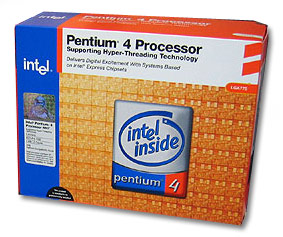 The first full-scale unveiling
of Intel's 64-bit technology on the desktop level is the new '6xx' line of Pentium
4 processors, along with the new 3.73GHz Extreme Edition chip. All of
these Socket 775 processors contain the EM64T extensions as well as a couple of
other major new hardware changes.
The first full-scale unveiling
of Intel's 64-bit technology on the desktop level is the new '6xx' line of Pentium
4 processors, along with the new 3.73GHz Extreme Edition chip. All of
these Socket 775 processors contain the EM64T extensions as well as a couple of
other major new hardware changes.
The 6xx chip line includes the 630, 640, 650 and 660 at speeds of 3.0GHz,
3.2GHz, 3.4GHz and 3.6GHz respectively. All these processors use an 800 MHz bus
paired with DDR or DDR2 memory. A 3.8GHz version should appear in the next three
to four months also.
More notably, all of the chips in the 6xx
line, as well as the 3.73GHz P4 EE feature a massive
2MB of Level 2 cache memory. This is double the largest amount found on previous Pentium
4s, bringing these new chips into territory previously reserved for the outrageously
expensive EE (Extreme Edition) Pentium 4 chips and the newer Xeons.
The new 3.73GHz Extreme Edition processor gets a bump up to the shiny new
1066MHz bus to compensate for this loss of cache superiority; gotta keep those
product lines separate after all... It looks like there will be very little
point in investing in an EE P4 until Intel adds some more performance features
to the line, considering that these chips hold an almost 30% price premium over
even the new Pentium 4 660 processor.
The extra cache memory should assist in some
applications, most notably 3D rendering and database and content creation
applications. It will also introduce more
latency
which may be slightly
counter productive in certain situations.
Currently, a mere BIOS update should be all that's needed to update any Intel
Socket 775 board to work with EM64T enabled chips. Intel has stated that
they intend to enable the technology across their Pentium 4 and Celeron
processor lines by the end of the year.
EM64T will also eliminate the current 4GB memory addressing limit placed on
32-bit processors, though this will need a new generation of chipsets from Intel
to be implemented before we see any manifestation of this on the desktop.
Still it does for Intel servers what the AMD64 extensions and the Opteron did
for AMD; allow more memory in servers without performance reducing
add-ons.
The battle lines
between Intel and AMD for the future of the desktop and server
markets are now more sharply drawn. On one hand, AMD currently
has a more efficient interconnect system (on-die memory controller, Hypertransport) with less
bottlenecks, and still maintains a stranglehold on the performance gaming crown. They also
have the respect that goes with a proven 64-bit product that has
been accepted on all levels of the
marketplace.
On the
other hand, Intel's new chips have massively larger amounts of cache memory,
which could translate to some serious performance advantages in certain facets
of business computing. Also Intel deserves some kudos in our mind for
sticking with Socket 775 for 64-bit chips (for now at least). The new
64-bit capable chips keep the other advantages of the Prescott P4 architecture
too, including Hyperthreading capability and native SSE3
support.
